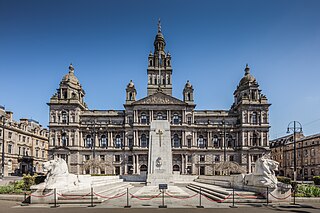
The City Chambers or Municipal Buildings in Glasgow, Scotland, has functioned as the headquarters of Glasgow City Council since 1996, and of preceding forms of municipal government in the city since 1889. It is located on the eastern side of the city's George Square. It is a Category A listed building.

George Square is the principal civic square in the city of Glasgow, Scotland. It is one of six squares in the city centre, the others being Cathedral Square, St Andrew's Square, St Enoch Square, Royal Exchange Square, and Blythswood Square on Blythswood Hill.

Pollokshields is an area in the Southside of Glasgow, Scotland. Its modern boundaries are largely man-made, being formed by the M77 motorway to the west and northwest with the open land of Pollok Country Park and the Dumbreck neighbourhood beyond, by the Inverclyde Line railway and other branches which separate its territory from the largely industrial areas of Kinning Park, Kingston and Port Eglinton, and by the Glasgow South Western Line running from the east to south, bordering Govanhill, Strathbungo, Crossmyloof and Shawlands residential areas. There is also a suburban railway running through the area.

The McLellan Galleries are a major exhibition space in the city of Glasgow, Scotland, situated behind a frontage of shops and offices in Sauchiehall Street.

Thomas Hamilton was a Scottish architect, based in Edinburgh where he designed many of that city's prominent buildings. Born in Glasgow, his works include: the Burns Monument in Alloway; the Royal High School on the south side of Calton Hill ; the Royal College of Physicians of Edinburgh; the George IV Bridge, which spans the Cowgate; the Dean Orphan Hospital, now the Dean Gallery; the New North Road Free Church, now the Bedlam Theatre; Cumstoun, a private house in Dumfries and Galloway; and the Scottish Political Martyrs' Monument in Old Calton Cemetery, Edinburgh.
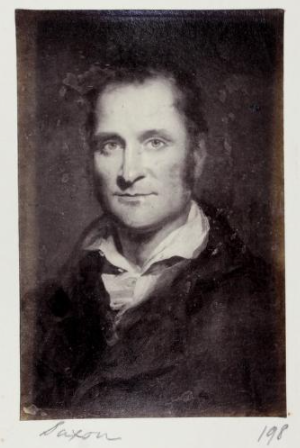
David Hamilton was a Scottish architect based in Glasgow. He has been called the "father of the profession" in Glasgow.
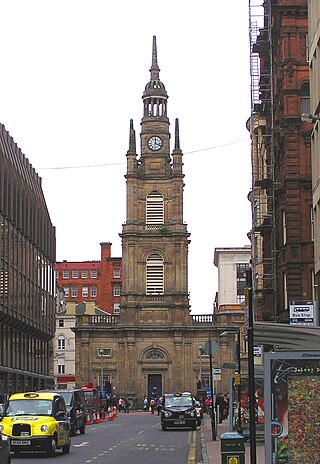
The St George's Tron Church, in Glasgow, Scotland, is a Church of Scotland church in the city centre, located in Nelson Mandela Place, previously known as St George's Place, fronting Buchanan Street at West George Street, along from Queen Street Station. It should not be confused with the 17th-century Tron Church, which lies to the south-west on Trongate and was redeveloped in the 1980s as the Tron Theatre. Located right on the busiest shopping street in Scotland, the building is a significant presence, and the oldest in the area. It stands as a terminating vista for West George Street.
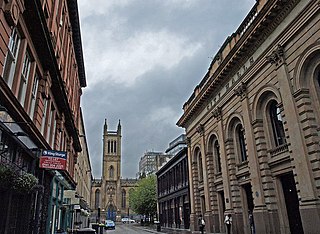
Glasgow's City Halls and Old Fruitmarket is a concert hall and former market located on Candleriggs, in the Merchant City, Glasgow, Scotland.

The Mitchell Library is a large public library and centre of the City Council public library system of Glasgow, Scotland.

The Theatre Royal is the oldest theatre in Glasgow and the longest running in Scotland. Located at 282 Hope Street, its front door was originally round the corner in Cowcaddens Street. It currently accommodates 1,541 people and is owned by Scottish Opera. The theatre opened in 1867, adopting the name Theatre Royal two years later. It is also the birthplace of Howard & Wyndham Ltd, owners and managers of theatres in Scotland and England until the 1970s, created by its chairman Baillie Michael Simons in 1895. It was Simons who as a cultural entrepreneur of his day also promoted the building of Kelvingrove Art Gallery and Museum and Glasgow's International Exhibitions of 1888 and 1901.
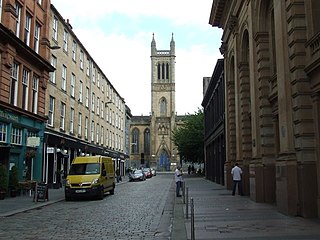
Candleriggs is a street in the city of Glasgow, Scotland. It is located in the Merchant City area of the city centre.

Sauchiehall Street is one of the main shopping streets in the city centre of Glasgow, Scotland, along with Buchanan Street and Argyle Street.

The Willow Tearooms are tearooms at 217 Sauchiehall Street, Glasgow, Scotland, designed by internationally renowned architect Charles Rennie Mackintosh, which opened for business in October 1903. They quickly gained enormous popularity, and are the most famous of the many Glasgow tearooms that opened in the late 19th and early 20th century. The building was fully restored, largely to Mackintosh's original designs, between 2014 and 2018. It was re-opened as working tea rooms in July 2018 and trades under the name "Mackintosh at The Willow". This follows a trademark dispute with the former operator of The Willow Tearooms which was resolved in 2017. This name is now used at tea room premises in Buchanan Street and was also additionally used at the Watt Brothers Department Store in Sauchiehall Street, Glasgow between 2016 and its closure in 2019.

Cathedral Square is a public square in the city of Glasgow, Scotland. Cathedral Square and precinct is situated adjacent to Glasgow Cathedral on High Street/Castle Street at John Knox Street. Nearby are many famous Glasgow landmarks such as Provand's Lordship, Glasgow Royal Infirmary, the Necropolis, the ceremonial Barony Hall of Strathclyde University, and the Glasgow Evangelical Church at the Square. It is one of six public squares and precincts in the city centre.

St. Enoch Square is a public square in Glasgow, Scotland, situated south of the junction of Buchanan Street and Argyle Street, two of the city's busiest shopping streets.

The Royal Exchange Square is a public square in Glasgow, Scotland. The square lies between Buchanan Street and Queen Street, opening out Queen Street and Ingram Street to the south of George Square. It is also easily accessible from Buchanan Street on the west side of the square, through two prominent archways at Royal Bank Place. The square is a landmark due to its distinguished architecture which attracts many visitors. It is one of six squares in the city centre.
Hutchesons' Grammar School is an independent day school for boys and girls aged 3–18 in Glasgow, Scotland. It was founded as Hutchesons' Boys' Grammar School by George Hutcheson and Thomas Hutcheson in 1641. Prospective pupils must sit an entrance test and interview to gain admission. The Boys' and Girls' schools amalgamated in 1976, at the grounds where the Boys' school had moved to almost two decades prior to form the current senior school. The Girls' school campus became the junior school and in 1994, a new pre-school block at the junior school was constructed. The school now has around 1,300 pupils across its Pre-school, Junior and Senior Schools.

Govanhill Baths is a Category B listed Edwardian public bathhouse at 99 Calder Street, Govanhill, Glasgow, Scotland, designed by the architect A.B. McDonald and opened between 1912 and 1917. The building itself is currently closed for refurbishment works until 2023. Govanhill Baths Community Trust operates from an office at 126 Calder Street, across the road from the baths building.

Rutherglen Town Hall is a municipal facility on the north side of Main Street in Rutherglen, Scotland. The town hall, which was the headquarters of Rutherglen Burgh Council, is a Category A listed building.


















